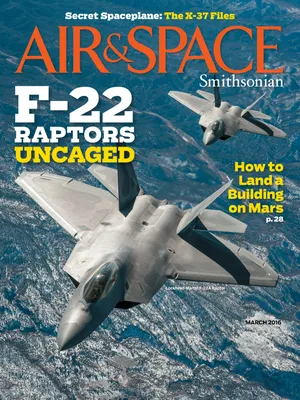What’s the X-37 Doing Up There?
The Air Force isn’t saying, so we asked other spaceplane experts.
/https://tf-cmsv2-smithsonianmag-media.s3.amazonaws.com/filer/3c/0e/3c0eaca7-a1b5-4b96-b7a0-c33a7b91aba6/08b_fm2016_2014_674dayssef14-12246-006_live.jpg)
It’s been five years since the first launch of the Air Force’s X-37B mini-shuttle, and outside observers—meaning those who lack the proper security clearances—still know little more about this mysterious unmanned vehicle than they did in 2010 (see “Space Shuttle Jr.,” Dec. 2009/Jan. 2010). But after three completed flights and a fourth launch last May (the spaceplane was still in orbit as of mid-December), they’re at least able to make educated guesses.
Despite the project’s general secrecy, the Air Force has been perfectly willing to release photos of the vehicle sitting on top of its Atlas V rocket at Cape Canaveral, Florida, and on the runway at Vandenberg Air Force Base in California where it lands, autonomously. The spaceplane’s dimensions are known: It’s small, about 29 feet long, with a cargo bay not much bigger than a pickup truck’s. Project officials have revealed that the X-37B’s maneuvering engine runs on hydrazine and nitrogen tetroxide, and that it uses a different kind of thermal protection than NASA’s space shuttle did. The durations of the first three missions are a matter of public record (224 days, 469 days, and 674 days), and while the orbital parameters aren’t officially disclosed, amateur astronomers have been able to spot the mini-spaceplane through telescopes and figure out that it’s been orbiting at relatively low altitudes.
At an aerospace meeting in 2011, Arthur Grantz, a chief engineer with Boeing, the company that built the X-37B, said that the program had been evaluating the vehicle’s autonomous navigation and other systems. While he didn’t say what the Air Force wanted with an operational spaceplane, he speculated that the vehicle could be modified in the future to carry passengers.
Before the most recent launch, the Air Force and NASA even revealed two of the payloads for the first time: a NASA materials science experiment and an ionizing thruster being tested for the Air Force. Those clues have led analysts to speculate with a little more confidence about the X-37B’s purpose.
It’s clear that any technologies tested on an Air Force spaceplane will have some military application, but that doesn’t narrow things down much. In space, it could mean communications, navigation, surveillance, or even anti-satellite and counter-anti-satellite operations. The smart money is on advanced surveillance sensors. The Air Force has never mentioned them directly, but everyone seems confident that they’re flying.
“I think that’s probably what they’re not telling you, that there are payloads in there that might be part of the design for future reconnaissance satellites,” says James Andrew Lewis, director and senior fellow in the Strategic Technologies Program at the Center for Strategic and International Studies. The Air Force has great interest in developing small, advanced sensors, he says, because it’s “looking to figure out how to transition from big, expensive satellites to smaller but equally capable satellites.”
The Hall thrusters on the current flight use an electric field to accelerate xenon propellant, producing a small but steady thrust that’s useful for many types of spacecraft, including military communications satellites already in orbit. Brian Weeden, technical adviser for the Secure World Foundation, thinks the Air Force might also be testing the thrusters with an eye toward placing reconnaissance satellites in lower orbits, so that imaging sensors could take higher-resolution pictures of targets on the ground.
“I think the clue is how low an orbit [the X-37B] is in,” says Weeden. The spaceplane is orbiting at an altitude of about 320 kilometers (a little under 200 miles), which is lower than the International Space Station. Low orbits require more maneuvering, and therefore more fuel, to maintain. And fuel adds weight. “One of the reasons that the traditional exquisite imaging satellites are so hard to launch is because they’re big and they’re heavy,” says Weeden. Hall thrusters could enable lighter, cheaper reconnaissance satellites to be orbited.
Right now the Air Force has two X-37B research vehicles. Are we likely to see an operational fleet, without the “X” designation? Weeden doesn’t think so: “My guess would be that [the spaceplane] itself would probably not move into an operational-type role, but that a lot of the technologies that it’s demonstrating, like the Hall effect thrusters, or whatever the sensor payloads are, are going to move into the operational role. That’s how it went with the X-planes of the 1950s and 1960s.”
If the Air Force does go for an operational fleet, “they could add different versions of the vehicle, larger versions in particular,” says Todd Harrison, a defense budget analyst at the Center for Strategic and International Studies. Harrison speculates that a bigger version of today’s X-37B, with a larger cargo bay, could conceivably bring military satellites back to Earth for maintenance or repairs, then return them to orbit.
That is, if a scaled-up vehicle fits inside a conventional rocket. Like most satellites, today’s X-37B is placed inside a protective shroud, then launched on a large Atlas V rocket. “I would guess that it’s going to be really hard to make a bigger version of the X-37B that can still fit inside a fairly standard shroud,” Weeden says.
Another option for the Air Force would be to update the two experimental spaceplanes. For example, to make them more flexible and possibly cheaper to operate, the Air Force could make them compatible with other launch vehicles, such as the SpaceX Falcon 9 or one of Orbital Sciences’ rockets.
Such modifications would depend on the budget the X-37B program receives as it moves out of the experimental phase. And those numbers are likely to remain every bit as secret as the spaceplane’s missions.
